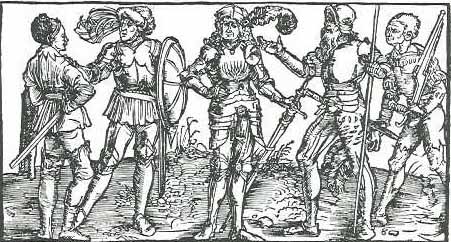
 |
||||||||
|
|
||||||||
By J. Clements
 While
recently visiting with some old friends and acquaintances I had not seen in
some twenty years, the subject came up of what everyone was now doing. When
it came to describe my "job" I tried to avoid sounding the slightest
bit pretentious when saying, "Well…strange as it sounds, I'm a researcher,
writer, and instructor of historical European martial arts." Once I had
explained that historical fencing was not the typical renn faire stunt fighting
or costumed escapism, and that I was not teaching about skinny featherweight
smallswords for sport, there was a certain respect expressed for having pursued
something so unusual with such passion. To my surprise most everyone remembered
that I had always been doing something along those lines and had an interest
in swordfighting. I hadn't realized it had always been that obvious. (I was
reminded of that old adage about how, if you can turn something you love doing
and do well into a career then you've accomplished something unique. It's certainly
true, but they never mentioned how it then becomes "work.")
While
recently visiting with some old friends and acquaintances I had not seen in
some twenty years, the subject came up of what everyone was now doing. When
it came to describe my "job" I tried to avoid sounding the slightest
bit pretentious when saying, "Well…strange as it sounds, I'm a researcher,
writer, and instructor of historical European martial arts." Once I had
explained that historical fencing was not the typical renn faire stunt fighting
or costumed escapism, and that I was not teaching about skinny featherweight
smallswords for sport, there was a certain respect expressed for having pursued
something so unusual with such passion. To my surprise most everyone remembered
that I had always been doing something along those lines and had an interest
in swordfighting. I hadn't realized it had always been that obvious. (I was
reminded of that old adage about how, if you can turn something you love doing
and do well into a career then you've accomplished something unique. It's certainly
true, but they never mentioned how it then becomes "work.")
Telling these people I now work in "Renaissance martial arts" led me to thinking about just what this subject actually is or is becoming. While I may personally consider this a "calling" and work full-time at it, I wondered, "What do others who hold the same interest consider the pursuit of this subject?" Calling it my "career" (it helps pay the bills) really doesn't define it for me. Maybe for some students it's just a pastime or diversion, but many others take it more seriously. It's surely far more than a hobby and yet much less than a field of employment--there's no job market for it that I'm aware of. The modern study and practice of Renaissance martial arts is not a competition sport--winning games is not the goal. It's not a craft either--it doesn't serve a real military function anymore and its modern self-defense application is far from primary. Entertainment alone is also not its function--the source handbooks of these historical killing arts were not choreography manuals.
In the eras the subject was developed and used, they called it an "art and a science" and today there is no question we practice it as an "art" -a Martial Art. As an "art" it's creative, expressive, individualistic, interpretive, open-ended, etc., and works within a set of given parameters. As an art it's something that can be pursued for its own sake without any ultimate objective. It is something we follow as a mental and physical challenge. Any art requires practice and training in its methods, and this is where research and study become involved. There is learning, there is discovery, and there is continual refinement and amendment. In the process we try to reconstruct, to rebuild, research, recover, and even to replicate the old skills and lost knowledge. We organize clubs to associate and cooperate in doing this and to share with one another our "art".
But because these teachings and skills became extinct or evolved into unrecognizable forms, they are not a living "tradition." So, in a sense then, the "schools" of the modern Renaissance martial artist are not physical structures or even locations but something inside us and all around us…in our tools and our texts and our online rooms. Whether we are learning from behind a computer screen or a book page, training with others, or laboring alone, as long as we really work at sincerely trying to understand the old ways and learn by teaching ourselves the physical principles and actions, we are all "working" at an Art.
As I told my old friends and colleagues what I now do, part of me was feeling rather silly…"renaissance" martial arts…fencing…swords… But then, I thought…heritage, history, cultural exploration, physical fitness…yes, these are worthwhile. Free from distractions of self-delusional fantasy and role-play, these are good and admirable things. I was reminded how the historical sources handbooks we follow as our guided are especially filled with lessons on good and principled behavior. I thought of the unarguable martial skills we have developed and of the unique value of our subject--exercise, camaraderie, historical exploration--and felt confident it is something to take pride in on whatever level you pursue it so long as you do so with integrity.
While we don't need these skills now as combative systems for our survival, on the higher levels as a martial art it's still something that can be about each individual's own personal struggle against adversity, a challenge to improve themselves, and perhaps their character, a continual path where the journey is more important than the destination. In our study of Renaissance martial arts we contribute to something that will endure beyond us.
|
|
|||
|
|
|||
|
|||